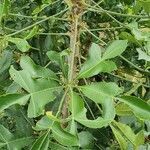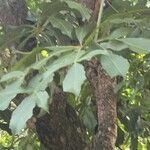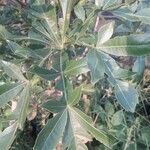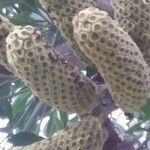A tree up to 17 m. or more tall, unbranched or with a sparingly branched bole, bearing a crown of large digitately compound leaves.. Petiole up to 67 cm. long and 1 cm. diameter, glabrous or minutely pubescent especially in stipular region; leaflets 6–12, sessile to petiolulate, rather coriaceous, pinnatifid to partially pinnate (fig. 2/1, 2), up to 35 cm. long by 19 cm. wide, glabrous or with a few scattered hairs; petiolules up to 8 cm. long, often narrowly winged for some distance.. Spikes pedunculate (fig. 3/3); flowering region occupying one-quarter to six-sevenths of the rhachis; floral bracts up to 3 mm. long, ciliate, inconspicuous.. Fruits subobconical to wedge-shaped, often constricted immediately below stylopodium, up to 12 mm. long, glabrous or minutely puberulous.. Figs. 2/1, 2 (p. 9), 3/3 (p. 10).
A thickset tree. It grows 3-10 m tall. The bark is yellowish-grey. It is thick and corky. The leaves are crowded near the ends of the branches. They are compound leaves and up to 70 cm across. There are 5-9 leaflets from the end of a stout leaf stalk. This can be 40 cm long. The leaflets are dark green or bluish-green. They are lobed and dissected. The edge has sharp teeth. The flowers are greenish-yellow. They are closely packed along 8-12 thick spikes. These are 5-15 cm long by 1.5-4 cm wide. The fruit is angular. It is 4-6 mm across. They are purple when mature.
Leaves digitately compound (but palmate or even simple and ± entire in juvenile forms); petiole up to 50(67) cm. long, usually glabrous but sometimes slightly pubescent.
Leaflets 6–9(12), up to 30(35) × 15(19) cm., sessile or with distinct petiolules, coriaceous, glabrous to subglabrous; lobes very variable in outline.
Tree, 6-18 m high. Leaves bi-or multidigitately compound and dark green; primary petiolule winged. Flowers in simple spikes; green or creamy.
Fruit obconical-ellipsoid, very densely packed together and consequently faceted, up to 12 mm. long, glabrous or very slightly puberulous.
Leaves of mature trees characterized by the presence of prominent wedge-shaped decurrent wings on the petiolules (connate stipules).
Thick-stemmed tree to 10 m. Leaves 2-digitate, leaflets vertebrate-digitate. Flower spikes umbellate, greenish yellow.
Tree up to 17 m. high, but commonly 5–10 m., often with an unbranched trunk, but sometimes with sparse branches.
Flowers sessile, with small narrowly lanceolate floral bracts; stylopodium short.
Spikes very dense, with obvious distinct peduncles and basal bracts.




